The AMD Radeon R9 295X2 Review
by Ryan Smith on April 8, 2014 8:00 AM EST- Posted in
- GPUs
- AMD
- Radeon
- Radeon 200
Compute
Our final set of performance benchmarks is compute performance, which for dual-GPU cards is always a mixed bag. Unlike gaming where the somewhat genericized AFR process is applicable to most games, when it comes to compute the ability for a program to make good use of multiple GPUs lies solely in the hands of the program’s authors and the algorithms they use.
At the same time while we’re covering compute performance for completeness, the high price and unconventional cooling apparatus for the 295X2 is likely to deter most serious compute users.
In any case, our first compute benchmark is LuxMark2.0, the official benchmark of SmallLuxGPU 2.0. SmallLuxGPU is an OpenCL accelerated ray tracer that is part of the larger LuxRender suite. Ray tracing has become a stronghold for GPUs in recent years as ray tracing maps well to GPU pipelines, allowing artists to render scenes much more quickly than with CPUs alone.
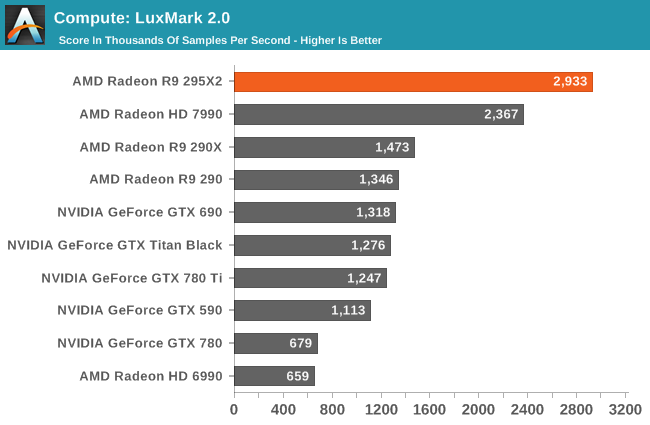
As one of the few compute tasks that’s generally multi-GPU friendly, ray tracing is going to be the best case scenario for compute performance for the 295X2. Under LuxMark AMD sees virtually perfect scaling, with the 295X2 nearly doubling the 290X’s performance under this benchmark. No other single card is currently capable of catching up to the 295X2 in this case.
Our second compute benchmark is Sony Vegas Pro 12, an OpenGL and OpenCL video editing and authoring package. Vegas can use GPUs in a few different ways, the primary uses being to accelerate the video effects and compositing process itself, and in the video encoding step. With video encoding being increasingly offloaded to dedicated DSPs these days we’re focusing on the editing and compositing process, rendering to a low CPU overhead format (XDCAM EX). This specific test comes from Sony, and measures how long it takes to render a video.
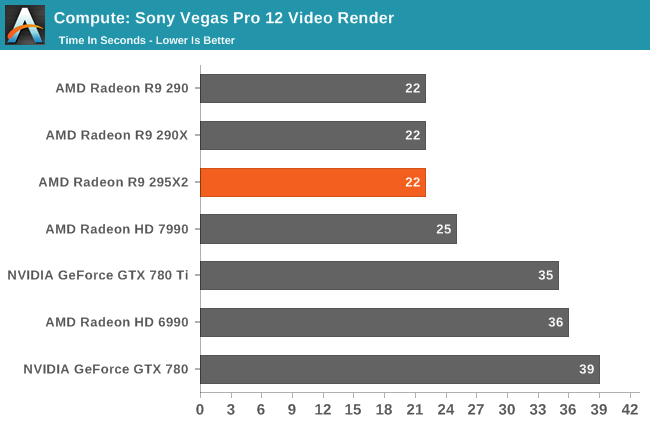
Sony Vegas Pro on the other hand sees no advantage from multiple GPUs. The 295X2 does just as well as the other Hawaii cards at 22 seconds, sharing the top of the chart, but the second GPU goes unused.
Our third benchmark set comes from CLBenchmark 1.1. CLBenchmark contains a number of subtests; we’re focusing on the most practical of them, the computer vision test and the fluid simulation test. The former being a useful proxy for computer imaging tasks where systems are required to parse images and identify features (e.g. humans), while fluid simulations are common in professional graphics work and games alike.
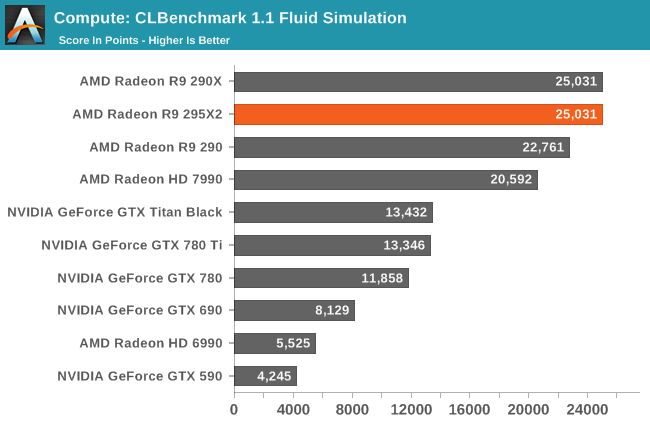

Like Vegas Pro, the CLBenchmark sub-tests we use here don't scale with additional GPUs. So the 295X2 can only match the performance of the 290X on these benchmarks.
Moving on, our fouth compute benchmark is FAHBench, the official Folding @ Home benchmark. Folding @ Home is the popular Stanford-backed research and distributed computing initiative that has work distributed to millions of volunteer computers over the internet, each of which is responsible for a tiny slice of a protein folding simulation. FAHBench can test both single precision and double precision floating point performance, with single precision being the most useful metric for most consumer cards due to their low double precision performance. Each precision has two modes, explicit and implicit, the difference being whether water atoms are included in the simulation, which adds quite a bit of work and overhead. This is another OpenCL test, as Folding @ Home has moved exclusively to OpenCL this year with FAHCore 17.
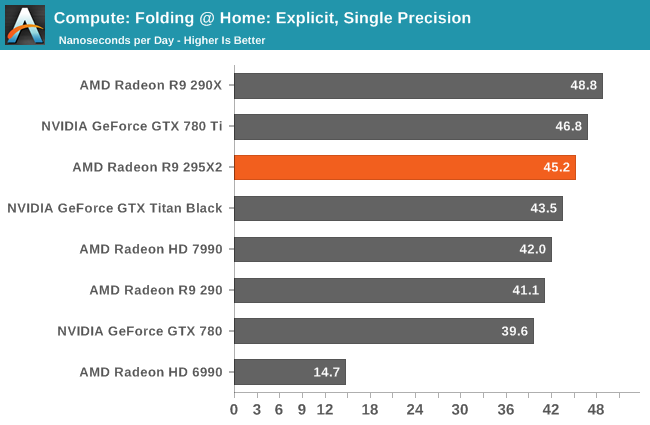
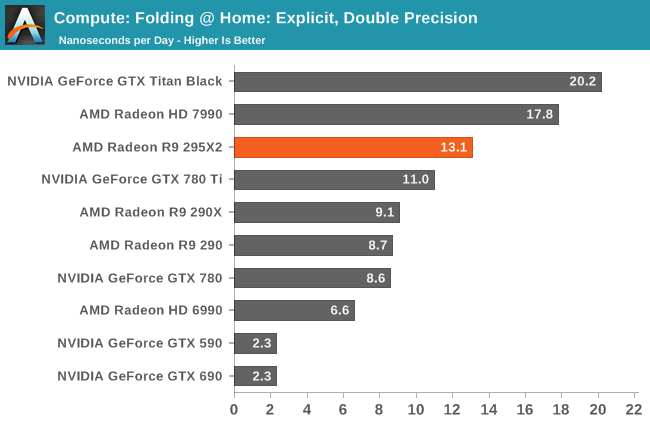
Unlike most of our compute benchmarks, Folding@Home does see some degree of multi-GPU scaling. However the outcome is really a mixed bag; single-precision performance ends up being a wash (if not a slight regression) while double-precision is seeing sub-50% scaling.
Wrapping things up, our final compute benchmark is an in-house project developed by our very own Dr. Ian Cutress. SystemCompute is our first C++ AMP benchmark, utilizing Microsoft’s simple C++ extensions to allow the easy use of GPU computing in C++ programs. SystemCompute in turn is a collection of benchmarks for several different fundamental compute algorithms, as described in this previous article, with the final score represented in points. DirectCompute is the compute backend for C++ AMP on Windows, so this forms our other DirectCompute test.
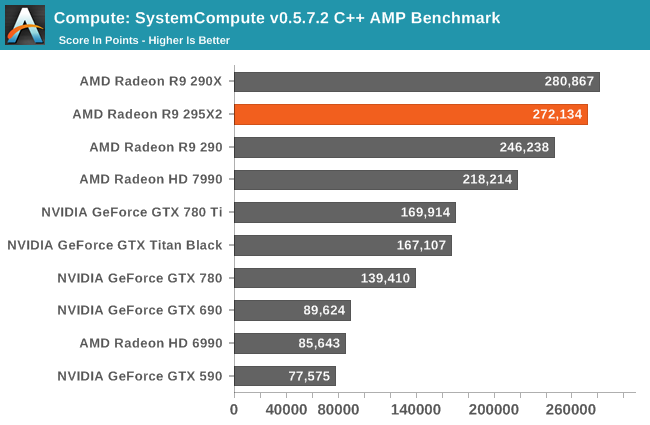
Our final compute benchmark has the 295X2 and 290X virtually tied once again, as this is another benchmark that doesn’t scale up with multiple GPUs.










131 Comments
View All Comments
Dupl3xxx - Wednesday, April 9, 2014 - link
$2k+ for a 4k screen? where are you wasing your money? In norway, you can get a 4k screen for just about 5kNOK, or just about 850USD, including tax! also, why would you need a $1500 CPU, whene the 4930k is 200MHz slower, for half the price?Also, WHY would you want 32GB of 2400MHz ram!?!?!?! There is next to no improvement over 1600MHz!
As far as SSD's goes, a single samsung 250/500GB should be plenty, you got 32GB of ram to use as buffer!
And if you want a "tight" system with insane preformance, the 295x2 is the best choice ATM. Double the 290x preformance, "half" the size.
lehtv - Wednesday, April 9, 2014 - link
Another difference is the way this card handles heat compared to any 290X CF setup apart from custom water cooling. The CLLC combines the benefits of reference GPUs - the ability to exhaust hot air externally rather than into the case - with the benefits of third party cooling - the ability to keep temperatures and noise levels lower than those of reference blower cards. A 290X crossfire setup using reference cooling is not even worth considering for anyone who cares about noise output, while third party 290X crossfire is restricted to cases with enough cooling capacity to handle the heat.Supersonic494 - Friday, April 11, 2014 - link
You are right, but keep in mind on big limitation with normal crossfire/SLI is the space taken up by 2 big dual slot GPUs, with this it is only one slot; however other than that you might as well get 2 290x'sbj_murphy - Friday, April 11, 2014 - link
Dual GPU doesn't have the requirement for 2 PCI-E slots; you can't do SLI/Crossfire in a Mini-ITX system for example.HalloweenJack - Tuesday, April 8, 2014 - link
muppet - 20w more in furmark , and 160 in games - not hundreds more. keep drinking the ananadtech koolaid.WaltC - Tuesday, April 8, 2014 - link
Interesting. [H] seems to have done some pretty thorough testing, and the AMD card blows by 780Ti SLI in every single case. Of course, [H] is testing @ 4k resolutions/3-way Eyefinity exclusively--but that's where anyone who shells out this kind of money is going to be. 1080P? Don't make me laugh...;)WaltC - Tuesday, April 8, 2014 - link
Can't edit, so I'll just say I don't know where "1080P" came from...;)lwooood - Tuesday, April 8, 2014 - link
Apologies for going slightly OT. Is there any indication when AMD fills in the middle of their product stack with GCN 1.1 parts?sascha - Tuesday, April 8, 2014 - link
I like to know that, too!MrSpadge - Tuesday, April 8, 2014 - link
I would say that indication is 20 nm chips, at the end of the year the earliest.